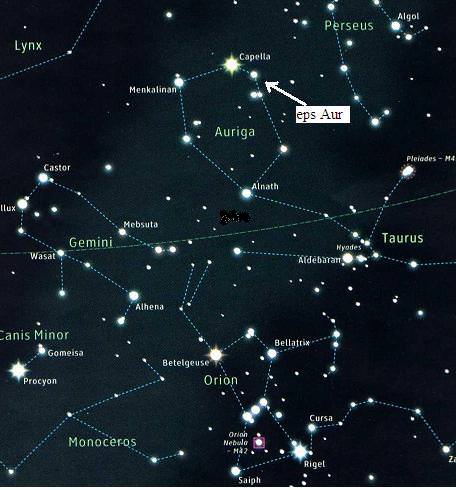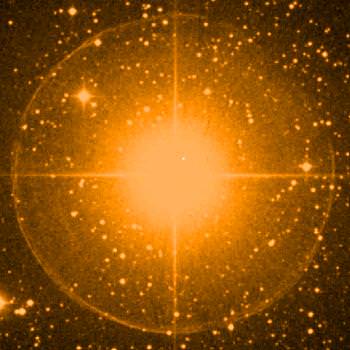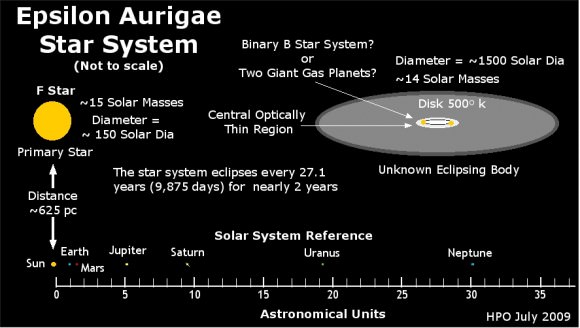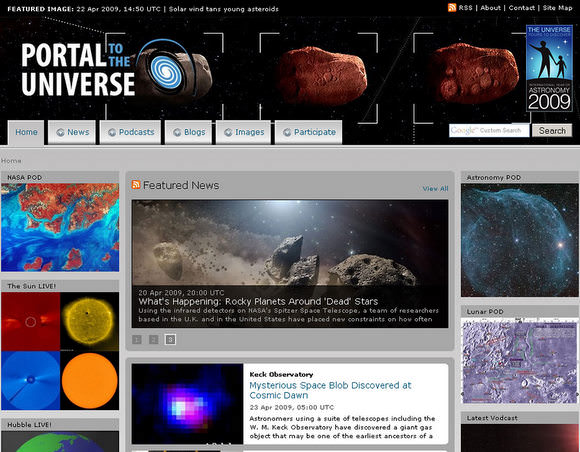[/caption]
One of the most important goals of the International Year of Astronomy is to “promote widespread access to the universal knowledge of fundamental science through the excitement of astronomy and sky-observing experiences.” What’s the objective? “Enable as many laypeople as possible, especially children, to look at the sky through a telescope and gain a basic understanding of the Universe.” And how is this going to be facilitated? By the “number of laypeople, especially young people and children, viewing the Universe through a telescope at street astronomy events, star parties, professional observatory webcasts etc.” and the “number of ‘cheap’ new telescope kits produced, assembled and distributed.” Well, the Celestron FirstScope Telescope hits the mark perfectly as aimed at anyone, able to view the Universe and inexpensive, but it’s anything but cheap…
In 1609, world-renowned Italian scientist, Galileo Galilei, introduced an elementary telescope to the growing astronomy community which sparked interest into the mysterious night sky for centuries to come. Four centuries later, in celebration of the International Year of Astronomy 2009, Celestron offers the portable FirstScope Telescope. The FirstScope pays tribute to Galileo Galilei and many of history’s most notable astronomers and scientists by displaying their names around the optical tube. We honor the contributions of these men and women, who brought us one step closer to understanding the universe around us.
When I first read the introduction and saw the first images of the Celestron Firstscope Telescope, I knew that I’d have to get my hands on one. They are a unique little altazimuth reflector – a tabletop model that bears a strong resemblance to the dobsonian design. Of course, I read the specifications, and I knew that a 76 mm (2.99 in) aperture reflector optical tube with a 300 mm (11.81 in) focal length wasn’t going to be a whole lot large than a tennis ball can, but I’ve learned that small telescopes are quite capable of performing some amazing feats when put into the right hands. According to what I’ve read the Celestron First Scope is a nice, fast focal ratio of f/3.95… and from what I know of Celestron telescopes, it should behave quite nicely. But there’s only one problem.
They aren’t available on the market yet.
So who would be the kind of person to wander around NEAF confronted with telescopes worth tens of thousands of dollars, but would be the one to take off to neverland with a kid’s telescope that cost less than $50? Yeah. You’re right. Me.
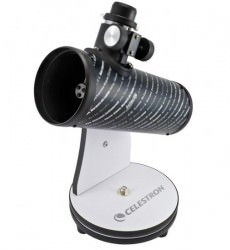 From the moment I laid eyes on the little black sonotube covered with the most famous names in astronomy, I was charmed. The mount is absolutely made out of enamel covered pressboard and its bearing is basically a big locking nut… But, hey. So am I. I took the whole thing apart and put it back together again (sans removing primary mirror cell, secondary and focuser – because I didn’t want to have to go “borrow” a laser collimator) in a matter of minutes and I found it surprisingly well constructed. Both the base and the bearing are going to hold up to use… And I don’t mean just casual use… I mean good, hard, honest-to-goodness kid use. Unlike a dobsonian, the side bearing needs to be loosened to move the telescope in its “up and down” path and re-tightened to hold position, but the user is faced with two options. The bearing is machined well enough that it can be placed to the “just snug” point where friction holds it in place and allows for minor movements (such as slight tracking adjustments) and it is quite strong enough to allow for thousands of tightening (and overtighenings) as the years go past. If something should strip out? These are common parts. It can be replaced with trip to the hardware store.
From the moment I laid eyes on the little black sonotube covered with the most famous names in astronomy, I was charmed. The mount is absolutely made out of enamel covered pressboard and its bearing is basically a big locking nut… But, hey. So am I. I took the whole thing apart and put it back together again (sans removing primary mirror cell, secondary and focuser – because I didn’t want to have to go “borrow” a laser collimator) in a matter of minutes and I found it surprisingly well constructed. Both the base and the bearing are going to hold up to use… And I don’t mean just casual use… I mean good, hard, honest-to-goodness kid use. Unlike a dobsonian, the side bearing needs to be loosened to move the telescope in its “up and down” path and re-tightened to hold position, but the user is faced with two options. The bearing is machined well enough that it can be placed to the “just snug” point where friction holds it in place and allows for minor movements (such as slight tracking adjustments) and it is quite strong enough to allow for thousands of tightening (and overtighenings) as the years go past. If something should strip out? These are common parts. It can be replaced with trip to the hardware store.
Now for the optical tube…
 Good old sturdy sonotube. I used to be afraid of “cardboard” many years ago, but I’ve learned with time. Despite what you might think, it holds up to dew, cools down to ambient temperature like a dream, and really has its advantages – like not dinging easily. The 1.25″ rack and pinion focuser on the Celestron FirstScope Telescope is very standard and a tiny bit stiff, but we’re not talking cotton candy here. The focuser is surprisingly quality, well-machined, and is going to withstand use and abuse. It has excellent clearance from the secondary and more than sufficient enough backfocus to allow for a wide variety of eyepieces. What’s that you say about eyepieces? Oh, yeah. Again, Celestron has outdone themselves by providing two 1.25″ eyepieces – a 20mm and a 4mm. Did I hear you groan? Yeah. Me, too. A 4mm is simply too much magnification for a scope that size, but when testing it on a larger, more stationary target (like the Moon) I found it wasn’t too bad. Again, surprising quality because the eyepieces and focuser alone were worth what the telescope cost!
Good old sturdy sonotube. I used to be afraid of “cardboard” many years ago, but I’ve learned with time. Despite what you might think, it holds up to dew, cools down to ambient temperature like a dream, and really has its advantages – like not dinging easily. The 1.25″ rack and pinion focuser on the Celestron FirstScope Telescope is very standard and a tiny bit stiff, but we’re not talking cotton candy here. The focuser is surprisingly quality, well-machined, and is going to withstand use and abuse. It has excellent clearance from the secondary and more than sufficient enough backfocus to allow for a wide variety of eyepieces. What’s that you say about eyepieces? Oh, yeah. Again, Celestron has outdone themselves by providing two 1.25″ eyepieces – a 20mm and a 4mm. Did I hear you groan? Yeah. Me, too. A 4mm is simply too much magnification for a scope that size, but when testing it on a larger, more stationary target (like the Moon) I found it wasn’t too bad. Again, surprising quality because the eyepieces and focuser alone were worth what the telescope cost!
How did it perform? If you aimed the Celestron FirstScope at something large, you’d be doing fine if you were a beginner, but like most small optical tube assemblies – it isn’t offered with a finderscope. While reflex sighting along the tube isn’t too hard to do, I can also see where that could be extremely frustrating for someone a bit more new to the game. So… I asked for a solution. Guess what? Celestron telescope had one that fit the criterion – inexpensive, but not cheap.
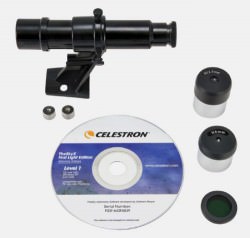 Enter the Celestron FirstScope Telescope Accessory Kit. People? For under $20 I just got handed a 1.25″ Celestron 12.5 mm eyepiece, 6mm eyepiece, moon filter, nifty little carry bag for the whole outfit, and get this… a 5X24 finderscope and bracket. No kidding! A real, honest-to-goodness optical finderscope… Not one of those “red dot” marvels that accidentally get left on and whose batteries run down and end up being totally useless next time you go out unless you have spares. Folks? You can’t even buy a moon filter for under $20, let alone a finderscope, eyepieces and… and… what’s this? Why, there’s even a CD ROM in here called “Sky X” that teaches you, prints maps, runs a planetarium program and more.
Enter the Celestron FirstScope Telescope Accessory Kit. People? For under $20 I just got handed a 1.25″ Celestron 12.5 mm eyepiece, 6mm eyepiece, moon filter, nifty little carry bag for the whole outfit, and get this… a 5X24 finderscope and bracket. No kidding! A real, honest-to-goodness optical finderscope… Not one of those “red dot” marvels that accidentally get left on and whose batteries run down and end up being totally useless next time you go out unless you have spares. Folks? You can’t even buy a moon filter for under $20, let alone a finderscope, eyepieces and… and… what’s this? Why, there’s even a CD ROM in here called “Sky X” that teaches you, prints maps, runs a planetarium program and more.
Am I impressed? Yes. I will give you fair warning that the Celestron FirstScope telescope is not the Hubble. I will stress to you repeatedly that you are not going to see majestic sweeping spiral arms on tiny galaxies – nor are you going to resolve globular clusters or reveal intricate planetary details. But, what you can expect from this telescope is far, far more than Galileo saw 400 years ago. When put on a steady surface, the Moon will display its tortured surface and Jupiter its moons. Bright, open star clusters will become things to marvel over and the Andromeda Galaxy will look like it truly is next door. Just as the rings of Saturn “disappeared” on Galileo so long ago, you will only see a fine line now to mark their place until the tilt changes again… But who cares when the summer skies are filled with bright nebula to explore, fuzzy globular clusters to capture and the Milky Way curls across the sky like a swarm of fireflies? Do it for your kids… Do it for your grandkids. Do it for yourself as a momento of IYA 2009. You won’t be disappointed.
It’s small wonder the Celestron FirstScope telescope named was Official Product of International Year of Astronomy 2009, for the FirstScope truly pays tribute to the men and women who brought us one step closer to understanding the Universe around us by putting an affordable “real telescope” into the hands of anyone who wants one. It won’t be long until they’re available at Celestron dealers everywhere, and you’ll find them for under $50 (and the accessory kit for under $20) at premier Celestron dealers like Oceanside Photo and Telescope, Scope City, High Point Scientific, Adorama and Astronomics.
Reminder to Universe Today Readers… Don’t forget! While all premier Celestron dealers will offer the FirstScope at the same price, you’ll get a discount for being a Universe Today reader if you enter our name in the Club Affliliation section if you chose to order a Celestron FirstScope from OPT.
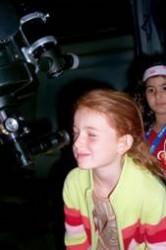 The Bareket Observatory’s Remote Internet Telescope stays at work doing imaging. During their event the scope took in such sights such as nebulae, star clusters, planets, and asteroids – all captured in real-time and integrated into a static image. Like our own IYA scope, they keep records of their images and you can visit with all their past work by just clicking around on the site.
The Bareket Observatory’s Remote Internet Telescope stays at work doing imaging. During their event the scope took in such sights such as nebulae, star clusters, planets, and asteroids – all captured in real-time and integrated into a static image. Like our own IYA scope, they keep records of their images and you can visit with all their past work by just clicking around on the site.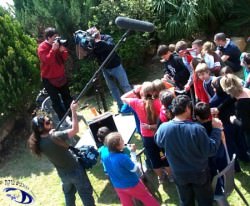 One of the most awesome things I’ve ever seen done is their way of translating astronomical images for the vision impaired. Mr. Marty Quinn , at Design Rhythmics Sonification Research Lab has applied image sonification parameters to the images in the IYA 2009 Bareket Observatory Deep Space Images Webcast so those who are without sight were able to perceive the images as music. How did they do it? The image color was translated into a scale of 9 instruments using Bareket’s recent standard developed in the “Walk on the Sun” science exhibit. In general, since the images are in black and white, the main instrument that expresses the image color in this case is the piano – although many were used. Isn’t that an awesome way to reach everyone?!
One of the most awesome things I’ve ever seen done is their way of translating astronomical images for the vision impaired. Mr. Marty Quinn , at Design Rhythmics Sonification Research Lab has applied image sonification parameters to the images in the IYA 2009 Bareket Observatory Deep Space Images Webcast so those who are without sight were able to perceive the images as music. How did they do it? The image color was translated into a scale of 9 instruments using Bareket’s recent standard developed in the “Walk on the Sun” science exhibit. In general, since the images are in black and white, the main instrument that expresses the image color in this case is the piano – although many were used. Isn’t that an awesome way to reach everyone?! 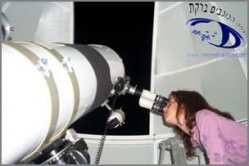 Once again, please take the time to visit Bareket Observatory’s Educational Pages and enjoy all the things they have to offer. The entire session is now available online as a V.O.D movie and this version for European viewers. It’s a great opportunity to all those who missed it, or would like to enjoy it again. Drop them a line and tell them how very much everything they do is appreciated!! It’s all about bonding our world together through astronomy.
Once again, please take the time to visit Bareket Observatory’s Educational Pages and enjoy all the things they have to offer. The entire session is now available online as a V.O.D movie and this version for European viewers. It’s a great opportunity to all those who missed it, or would like to enjoy it again. Drop them a line and tell them how very much everything they do is appreciated!! It’s all about bonding our world together through astronomy.

